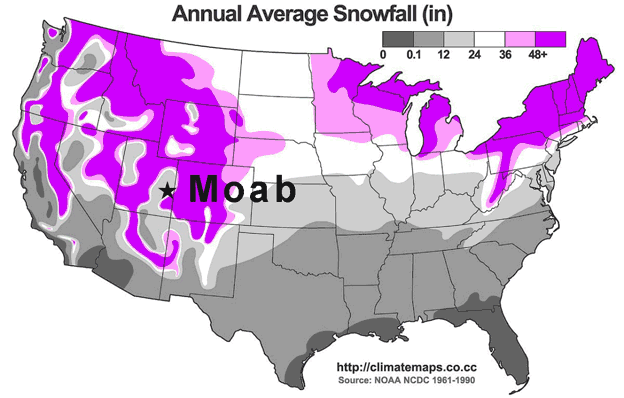If you search the internet for information about mountain biking in December, you’ll probably come across an article in the online magazine Singletracks: “The 9 Best Winter Mountain Biking Destinations in the Southwest.” It features the following map showing average snowfall across the US (for this article, I’ve superimposed Moab on the map:)

As someone who’s lived in Moab for 30 years, I was surprised that Singletrack listed Moab at the “top” of their list (after all, Moab is often referred to as “The Mountain Biking Capital Of The World.”) because winter riding here is at best uncertain and Moab is not known as a winter recreation hot spot. The reasons for that are varied, as is the amount of winter precipitation.
Precipitation Varies
Some winters, Moab can receive up to a foot of snow, or more. And many times, due to continuous cold and dry conditions, that snow will linger on the ground for weeks or months. But occasionally, entire months can pass without a single snowflake or drop of rain. This coming winter is forecast to be warmer and drier than normal and so could offer up great winter riding so long as you are prepared with appropriate clothing and can be flexible to ride during the warmest part of the day (typically between 1:00-4:00 pm).
Temperatures
Due to its 4,000 foot elevation, Moab in December is often fairly cold – average lows range around 20 degrees, while highs might average just above 40.
Call Ahead
When Moab has snow cover, the biking trails can be nearly unusable except for riders who have wide tire fat bikes that can handle snowy trails. A few local fat bikers utilize the groomed Nordic trails in the La Sal Mountains in winter so this may be an option if you are an avid fat bike enthusiast. And even if an intrepid biker were able to negotiate the trail, riding on it when the soil is softened by snow can severely damage the trail so it’s important for locals and visitors alike to contact our local bike shops for information and monitor Moab Trail Mix on Facebook, which posts trail condition alerts regularly.
The best advice for bikers considering a visit to Moab during December and January is to call ahead to check trail conditions.

That being said, when conditions in Moab are dry, biking in December and January can be wonderful (if sometimes a bit chilly.) If you find yourself in Moab this winter and conditions permit riding, here are few tips to make your winter mountain biking safe and comfortable:
Protect Your Extremities
- Hands: Bring at least two pairs of gloves. If one pair gets soaked with sweat, you’ll have a second pair. The hands are the most vulnerable to wind chill.
- Head: Your helmet is designed for cooling. Buy a thin-fabric stocking cap or buff that fits under your helmet. Having this extra warmth on your head is key, but you also don’t want it too warm or you’ll be shedding it mid-ride. And, on super cold or windy days, consider a balaclava face warmer.
- Feet: Pro Tip — When dressing in the morning, after you put on your socks, wrap some thin plastic wrap, or even the corner of a plastic shopping bag, over your toes. Then put on your mountain biking shoes. This extra layer of wind resistance will key your toes from freezing.
Upper Body: Employ Layers! Start with a thin, wicking layer with long sleeves (merino wool is excellent). Add a medium weight long sleeve layer like a 1/4 zip poly fleece pullover. Wear a wind-breaking outer layer with some insulation like a soft shell jacket.
Lower Body: Knickers with knee socks are an excellent choice. Depending on temperature and wind expected, full length tights might be appropriate. Some riders prefer leg warmers to full length tights for better flexibility.
Start Uphill: When possible, plan your ride to put the majority of the climbing at the beginning, in order to build up body heat.
Remember to Drink Water: Even though the temperatures are cold, the air is still super dry! It’s easy to forget to drink enough when riding in winter. If it’s below freezing, hydration tubes might become iced up so consider an insulated water bottle inside your backpack.
Know Your Limits: For some folks, this is a no-brainer, but for others, it will pay to be aware of the extra toll the low temps take on your body and to perhaps shorten your ride. Also, be aware of the potential for ice on north-facing slopes, where the sun fails to shine.


